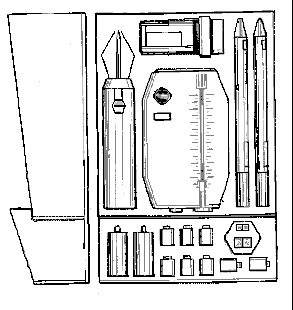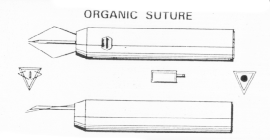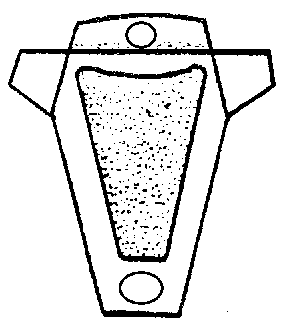

Imperial Klingon Battle Fleet
Congratulations! Today you are a warrior!
Welcome you to the Imperial Klingon Battle Fleet. We are a science fiction fan group who organize ourselves as KLINGON characters as in STAR TREK1 , STAR TREK THE NEXT GENERATION1 , STAR TREK DEEP SPACE NINE1 and the STAR TREK MOTION PICTURES1. Each crewman is expected to know a few things about Klingons, their culture, and physiology. Herein is a guide to what is currently known about Klingons, and their medicine.
|
1KLINGON, STAR TREK, STAR TREK THE NEXT GENERATION, STAR TREK DEEP SPACE NINE, STAR TREK VOYAGER and STAR TREK MOTION PICTURES are registered trademarks of PARAMOUNT MOTION PICTURES. No copyright infringement is intended or implied. |
KLINGON MEDICINE ANNEX
MEDICAL PHILOSOPHY
Many people outside of the Empire seem to think that Klingon medicine is very primitive. This is not true, as evidenced by the many breakthroughs in the genetic sciences that are only now being duplicated by Federation (and Romulan) scientists. The major difference in the medical care administered by Klingon and Federation medical personnel is in the concept of triage (the judgement made by the onsite medical personnel regarding the order of treatment of severely wounded or ill patients). Whereas Federation doctors would treat severe trauma patients on a worst wounded--first treated basis, Klingon doctors use entirely different criterion in this decision. The Klingon doctor must decide whether it would be cost effective to repair an individual. If it would be less costly to let an individual die (and train a replacement), the patient is not treated. On the other hand, if a patient's knowledge and skill is termed invaluable, no cost would be spared to save the patient's life.
Klingon doctors (and patients) do not worry much about pain. This is reflected in that Klingon doctors have fewer mild anesthetics and pain killers available to them. Klingons are not, however, adverse to using heavy pain blocking drugs to block crippling pain. If a pain killer is required to place an otherwise incapacitated man back on the job, a doctor will not hesitate to use it. Likewise, Klingons do not worry as much about how a repair looks as how well it functions. Plastic surgery for cosmetic purposes is unheard of, but its use in espionage is well known. If major surgery leaves a scar, this is readily accepted. Klingons wear their scars proudly.
MEDICAL EQUIPMENT

MEDICAL POUCH
: Unlike Federation doctors, Klingon medics have only one medical pouch, containing everything the doctor is likely to need. The medical pouch contains the following: one foam dressing applicator, one vital signs reader, one organic suture, two laser scalpels (beam diameter carried varies according to the perceived needs of the medical officer), one pneumatic hypodermic, two spare pressure cylinders, and nine medicine cylinders, including light and medium sedatives, light and medium stimulants, a general purpose poison antidote, a pain blocking drug, a pain enhancing drug, a truth drug, and an endurance booster. These items will be explained in greater detail in this section. Note also that Klingons do not have any functional equivalent of the smaller Federation medical field kit. This is not to say that Federation medics are underequipped. Rather, in situations where a Federation team's medical officer would carry only the small field kit, an equivalent Klingon team would likely have no medical officer along at all!

FOAM DRESSING APPLICATOR
: This is different from the Federation Spray Dressing only in appearance. When the unit is empty, screw cap disposable refills are available.

PNEUMATIC HYPODERMIC: A flat object shaped somewhat like a bar of soap, the hypodermic has two holes at one end for the insertion of one medicine cylinder and one air cylinder. At the opposite end is a wide screen which is the injector. The large upper surface consists of a slide for selecting the dosage to be injected, a push-button to inject the medication, and a two digit LED that tells the amount of medicine remaining in the medicine cylinder. A full medicine cylinder contains 10 units of medicine each. The hypodermic can inject up to two units at a time, but is usually set for one (that being the normal dose). An air cylinder contains enough pressure to give 50 injections, after which time it must be replaced.
DRUGS: The following drugs are typically available to a Klingon doctor: Light, Medium, and Heavy Stimulants, Light, Medium, and Heavy Sedatives, Tri-ox Compound, Sterilite, Neural Paralyzer, Endurance Booster, and a number of poison antidotes. Some of these drugs are described as follows:
ENDURANCE BOOSTER: This drug enhances the endurance of the patient for one to several hours, depending on the individual. Once the drug wears off, the individual will feel weak, or may even faint if severely weakened prior to taking the drug. The drug, despite its dangerous nature, might be given to a crewman or officer who could not be spared from his position at a critical moment. It would allow the person to return to duty temporarily.
PAIN BLOCKING DRUG: This drug will block all pain from any wound for several hours. During this time, the patient will feel no pain, and will not be rendered unconsciousness. Of course, if the victim weakens too much, he will still eventually pass out. Note that a person under the influence of this drug may not notice being injured further. This drug has a side effect, reducing the alertness of the individual during its effect period, thus making it unsuitable for widespread use on combat troops. Certain berserker units of Klingon Marines are believed to use this drug on suicide missions.
PAIN ENHANCING DRUG: This drug magnifies the pain that is felt by the victim. During the time that the drug is active the victim is also more resistant to pain-induced unconsciousness.
SUGGESTABILITY DRUG: For a time period lasting several hours, the victim is very suggestable. For most individuals, unless they are extremely resistant, the victim will believe whatever he is told, depending on the plausability of the statement involved. (If the victim is told that his hand is missing when it obviously is not, he will probably not believe this statement ..unless he for some reason cannot feel or see his hand.) The drug cannot force an individual to take actions he or she would not normally take, but the person can be influenced to believe something about another individual or situation which is not true, which may precipitate the desired action as if it was.

BIOSUPPORT & MONITOR SYSTEM: This device looks much like a large box with sensor cables, intravenous tubes, and one large cable running out of it. The cable is tipped with the standard data cart connector, and this requires the Biosupport & Monitor System be plugged into the data cart slot on the Portable Computing Recorder (see the EQUIPMENT section). These two units can be used to monitor vital signs and supply support suggestions. The Biosupport section also contains a large supply of drugs, which the unit can administer automatically in an emergency. (This feature can be overridden by the operator at any stage.) This device has several uses, from the support of massive-trauma patients to the support of prisoners undergoing traumatic torture.

LASER SCALPELS
: The laser scalpel is long and pencil-shaped, with a rechargable power supply plugging in the end. (A full charge will last about three hours of continuous use. ) There are seven beam diameters available: OO0, OO, 0, 1, 2, 3, and 5.DIAGNOSTIC / SUPPORT TABLE & PANELS: These are similar in many respects to the Federation versions, the basic differences being that the display is totally programmable (unlike the vertical slide scales of the Federation panel). The side panels not only provide a means of programming and/or retrieving medical data into the system, but also provide a large supply of drugs for the maintenance of the patient. These tables are also found in the operating room. In addition to the tables (and mounted to the wall between the tables) are surgical benches. These also contain a data retrieval system, and have two instrument trays that swing out for use. These instrument trays include both modern instruments and emergency backups (bladed scalpels, etc.)

VITAL SIGNS READER: The Vital Signs Reader is a hexagonal shaped object about 20 millimeters across and 12 millimeters thick. On the top surface it has a two digit LED and two control buttons. On the bottom surface is a sensor pad, and on one of the six sides is a recharge socket similar to that on the Laser Scalpel. A full charge on the Vital Signs Reader lasts about 10 hours. The Vital Signs Reader is not quite as handy to use as the Federation Medical Feinberger. It must be pressed, sensor pad down, against the skin of the patient, and then one or both of the buttons pressed. Pressing the left button reads out the heart rate of the patient, while pressing the right button gives the patient's respiration rate. Pressing both buttons at the same time will give the patient's blood pressure. The device requires a small amount of time before it will give the readout requested. During this time it must remain pressed against the skin of the patient. Anyone may use the device if they know which button (or buttons) to press.

ORGANIC SUTURE
: Unlike the Federation Protoplaser, the Klingons use an Organic Suture to close wounds. This device extrudes a very fine organic fiber, which is then literally knitted into the wound by the two small arms (somewhat as a spider spins a web) to seal the wound. In the back is a small fluid reservoir that holds enough fluid to last about thirty minutes of continuous use.

AGONIZER: The Klingon agonizer is carried by most top-rank officers aboard ship, most notably the Captain, First Officer, Security Officer, Medical Officer and Marine Officer. The short cylindrical device has a contact grid on one end, a finger-grip groove on the bottom, and a thumbslide on top which controls the intensity. Several other models of agonizer exist; they all have similar functions and variable intensity. The model shown at top is the Medical Agonizer, the one below is the Type 1 Standard Agonizer.
The medical agonizer is usually applied to the left shoulder to work properly. (The left chest position is preferred, or upper chest, and can make contact through normal light clothing. Sliding the thumbslide forward produces anything from mild discomfort to crippling pain to unbearable agony at the user's desire. The pain produced is not localized in the contact area, except at lower power settings.) It is mostly used for discipline and torture. In cases where an individual must be kept awake for a particular reason, and drugs are not available, the agonizer is commonly used. This may be for medical reasons, or for tactical situations.
There are rumors that certain cultures, perhaps even the Federation, have developed drugs which mask the agonizer effect. Such drugs would undoubtedly have side effects and would only be available to undercover agents and other critical personnel trained to use them only in emergency. Such drugs are known to exist within the Empire, but are highly illegal to produce, sell, use or possess.

|
1KLINGON, STAR TREK, STAR TREK THE NEXT GENERATION, STAR TREK DEEP SPACE NINE, STAR TREK VOYAGER and STAR TREK MOTION PICTURES are registered trademarks of PARAMOUNT MOTION PICTURES. No copyright infringement is intended or implied. |
Check us out!
IKBF Recruiting| the Imperial Klingon Battle Fleet | Transport to IKBF Links | Transport to IKBF Upcoming Events |
| Member Ships of the IKBF | Transport to Shore Leave | Transport to Farpoint | Klingon Language Institute |
|
|
|
|
House BuraD | Transport to Qor'etlh | Qor'etlh at Geocities | | <.counter D><.maillink><.time 24HR>
|